Wood routers are often categorized based on their form or size. There are seven types of routers based on the form, which are plunge, fixed-base, combo, compact, cordless, trim, and CNC routers. And in terms of size, there are three types, which are light-size, medium-size, and heavy-size routers.
![7 Types of Wood Router Tools Explained [With Pictures] Types of Wood Routers](https://homesthetics.net/wp-content/uploads/2023/11/Types-of-Wood-Routers.jpeg)
A router is one of the most essential tools of a professional woodworker these days, thanks to its versatility.
Not only is it used for cutting and shaping wood, but it is also used for trimming and detailing on plastic, metal, and a range of other materials. However, if you are new to woodworking, you may not know what a router exactly is and what its types are.
That is why I have discussed the different types of routers in this guide. So, if you are curious to know more, then dive in!
What is a wood router?
Before I get into its types, let me give you some idea about what this tool is. As I have stated before, a router (woodworking) is a machine that can be used to trim and shape different types of materials. It consists of a flat base at the bottom, along with a rotating blade or spindle bit that extends past the base.
The electric motor present inside the machine spins the blade or the router bit at speeds of over 30,000 revolutions per minute (RPM). That, in turn, allows the machine to shave off materials from the surface. Because of that, you can create grooves and patterns on the surface.
You can use a router for different types of tasks, such as creating straight, rounded, or concave edges, making a chamfer or a bevel, and so on. If you are skilled enough, you can use it for precision tasks like making complex curves and grooves. It can also be used for creating joinery structures like a dado (joinery), dovetail joint, mortise and tenon joint, and others.
A router is typically a handheld tool, but you can mount it on top of a router table (woodworking), converting it into a stationary machine with a fixed base. In this scenario, it becomes similar to a table saw, which is another common tool that is used for cutting wood. However, it is not nearly as versatile as a router.
Routers can be classified into different types based on factors like form and size. In the following sections, I have discussed the different types of routers in greater detail.
7 types of wood routers based on form
When I say form, I am referring to the overall design of the router. In that context, there are three different types of wood routers based on the form, which have been described below.
1. Plunge router
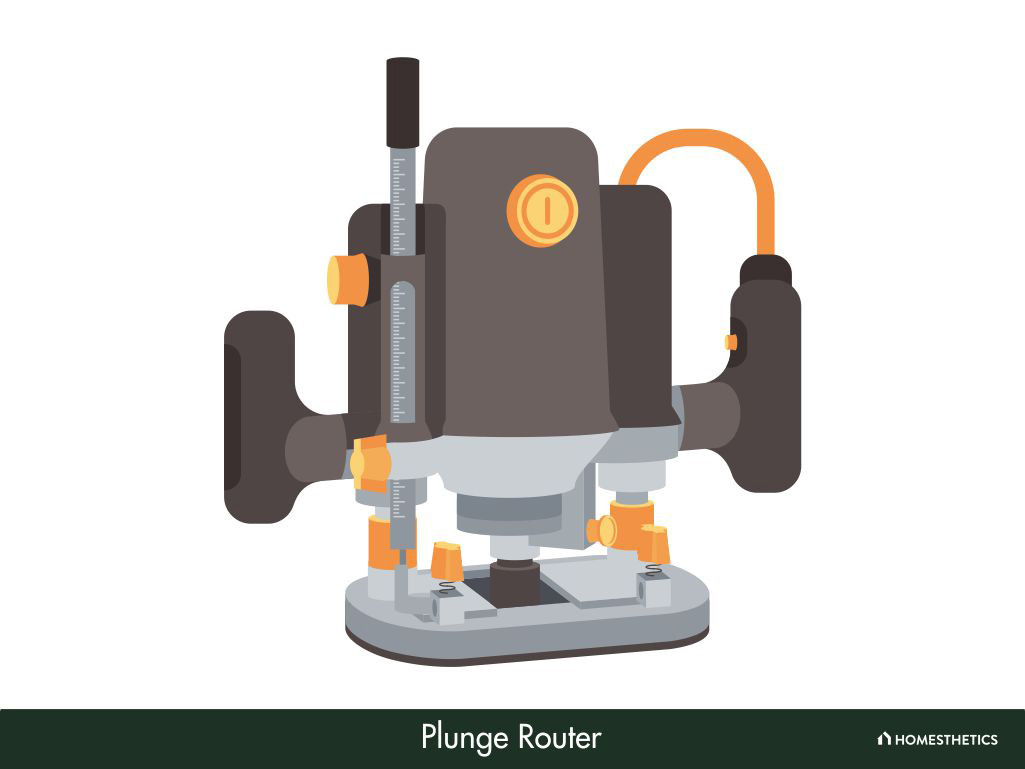
This is one of the most common types of wood routers that is used today. Also known as a plunge base router, this woodworking tool can be used to create deep groove patterns on wood, as well as dadoes and templates.
A typical plunge router has a body that is attached to the base with the help of two metal bars. The body houses the motor and the cutting bit, raised just above the working area. This pair of metal bars allows the body to move up and down repeatedly. The vertical movement of the housing helps to bore through the working surface.
So, to use a plunge router, you will have to position it directly over the object. When you turn the machine on, the router bit will drill into the surface to create holes and grooves.
If you use a good drill bit or cutting blade, you can use a plunge router to perform high-precision tasks. Likewise, plunge routers usually come with variable speed settings, which allow you to adjust the rate at which the drill bit cuts through the material.
2. Fixed-base router
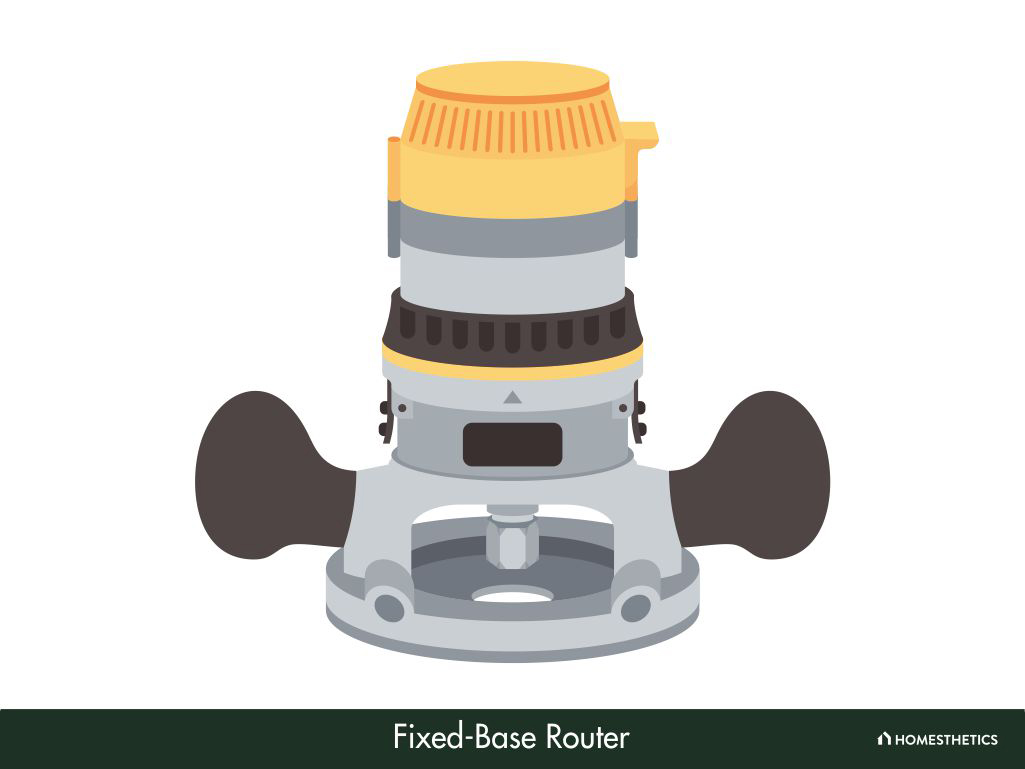
The fixed-base router is another common option used by woodworkers. Fixed-base routers are highly versatile tools that can be used for a wide range of cutting and drilling tasks. Thus, if you are looking for a multipurpose router, you should consider getting this option.
That said, a fixed-base router has a fairly complex design, which can make it a bit intimidating for beginners. It consists of a powerful electric motor that is attached to a flat metal base. Adjacent to the motor housing, you will find handles to hold the machine, as well as depth and speed adjustment knobs.
The handles are necessary because the tool generates a considerable amount of centrifugal force when in use. If you do not hold on to it firmly, then you will lose control of the machine easily, which can be dangerous.
3. Combo router
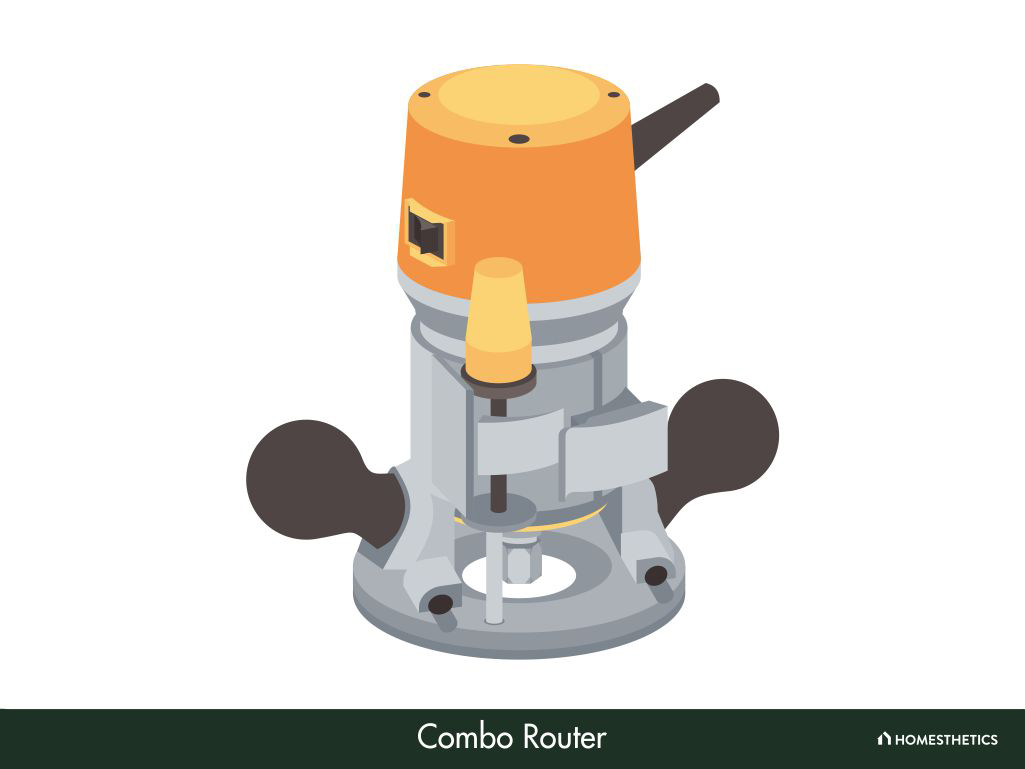
As you can guess from the name, a combo router combines the features of both plunge and fixed-base models. Such a type of router comes with a frame that can be used interchangeably with a plunge base and a fixed base.
Naturally, a combo router can be used for different types of woodworking and cabinetry tasks. You can use it for creating joints, dadoes, and grooves, as well as trimming lumber edges, beveling door and window frames, creating patterns, carving shapes, and many more.
However, the versatility and features come at a steep price, which is a drawback of this type of router. Also, based on my observations, beginners may find combo routers fairly complicated to use.
If you are not very experienced with routers, you may have difficulty deciding on which base to use for specific tasks. Similarly, it might take you a long time to set up the router before you can start using it.
4. Compact router

Unlike the two types of routers that I have described before, a compact router features a small and lightweight design (hence the name). It is essentially a small-scale version of a regular fixed-base router that you can hold in the palm of your hand. Because of this reason, it is otherwise known as a palm router.
Do not be fooled by its small size, though, for this type of router can pack a punch! As per my expertise, the compact router models that are sold today come with relatively heavy-duty motors. While it may not be as powerful as a full-sized plunge or fixed-base router, it is good enough for most types of woodwork, such as drilling, cutting, or trimming.
Thanks to that aspect, you will get the same work quality with these tools as you get with a regular fixed-base router. Moreover, the smaller size of this router makes it easy to use, especially for beginners and casual DIYers.
Since the drill bit is comparatively small, you will get better precision and accuracy with this type of router. Its small size makes it better suited to reach the tough corners of a furniture piece. However, using it on large surfaces and lumber pieces can be inefficient and time-consuming.
5. Cordless router

As the name suggests, a cordless router does not come with any cords. Instead, it is powered by a rechargeable battery, which sets it apart from other types of routers. It is pretty easy to use since you do not have to worry about pesky wires and power cords littered all over the workspace. That can consequently help to keep your workplace cleaner and more organized.
In terms of usability, cordless routers are best suited for light or medium woodworking jobs. Based on my trials, I can say that it is great for tasks like shaping edges or trimming. While the rotational speeds are almost as high as corded models in these tasks, it will start to slow down when used on hardwood, steel, or other rigid surfaces.
That’s because the motor is not as powerful as a conventional corded model in most cases. Also, you will need to recharge the battery more often if you use it extensively. These aspects can limit the scope of this tool for professional carpenters and woodworkers. However, if you are a beginner, you will find it quite beneficial.
6. Trim router
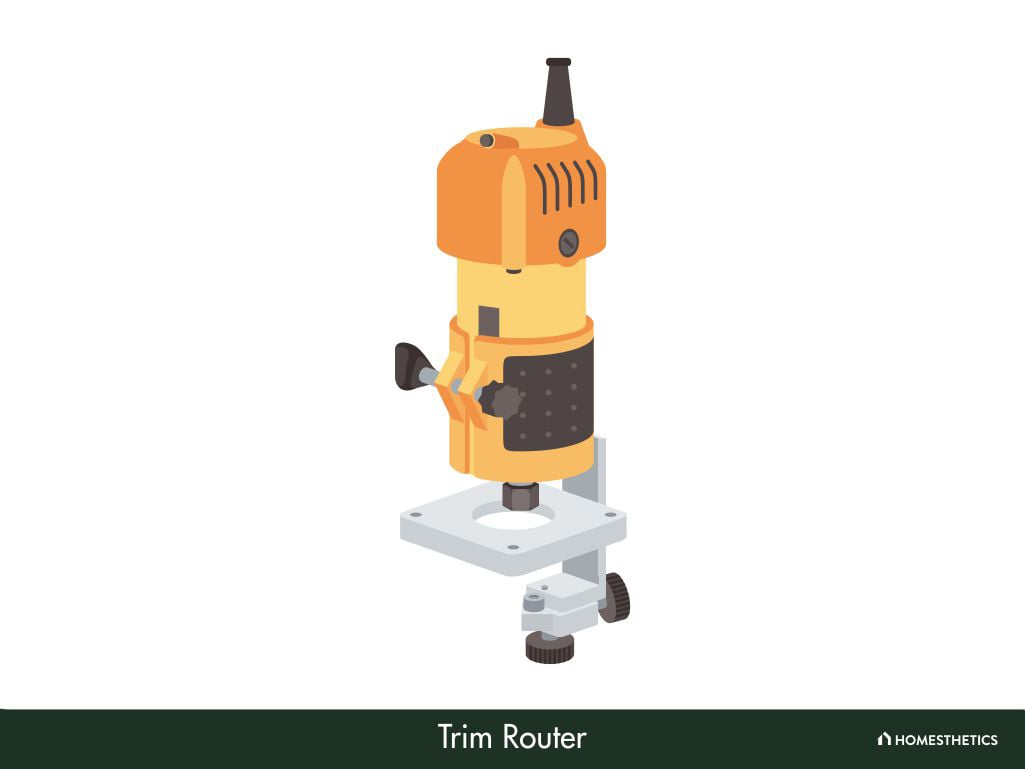
A trim router is a special type of router that is used for trimming laminate surfaces. Because of that reason, these routers are also known as laminate trimmers. After you perform plastic lamination on a plywood or metal base, you will need to trim their edges to get rid of any excess laminate. This task can be performed with the help of such a router.
In terms of size, these routers are even smaller than compact routers, and they are extremely lightweight. These features make the tool easy to hold and operate. Apart from that, the motor can spin the drill bit at a high RPM, which is particularly beneficial for trimming laminate surfaces. That’s because the high rotational speed prevents the lamination from shattering.
On the flip side, this type of router is not suitable for cutting or drilling through hardwood or other rigid materials. Similarly, the tool won’t be very efficient for trimming large lumber pieces either.
7. CNC router

A CNC router is another specialized tool that is used primarily by professional woodworkers in an industrial setting. The acronym CNC stands for “computer numerical controlled,” which means that this type of router is operated with the help of computer programs. Therefore, if you do not have adequate expertise, you won’t be able to use this machine.
This type of router is pretty expensive to purchase and has considerably large dimensions. That is why it is often used in woodworking industries, for regular people and individual woodworkers won’t be able to afford or accommodate it.
With that being said, CNC routers are designed for high-precision woodworking tasks. On top of that, they are extremely versatile and can perform any type of job, regardless of the complexity or scope. Aside from that, the tool is equipped for bulk processes, which is common within an industrial setting. In other words, it can perform a high volume of woodworking tasks in a short time.
3 types of routers based on size
The size of a router refers not only to the overall dimensions of the router but also to the capability of the machine to handle different types of workloads. Naturally, larger routers will be equipped with heavy-duty components, meaning that they will be able to handle heavier workloads with ease. Smaller routers, on the other hand, will only be suitable for small-scale woodworking projects.
In any case, I have discussed the different types of routers based on the size below.
1. Light-size router
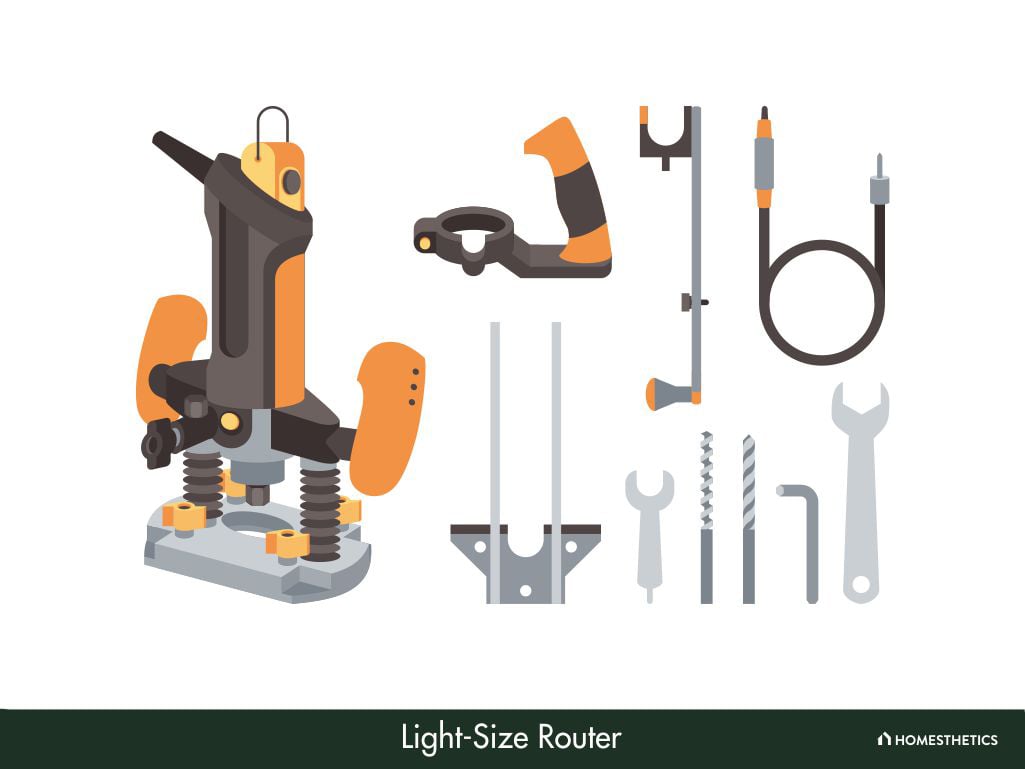
Light-size routers have relatively compact dimensions and are designed to be lightweight. The internal components of these routers, such as the drill bits and collets, are comparatively small. As I experienced it first-hand, these routers can often accommodate drill bits that have a diameter of less than 0.25 inches.
Similarly, the collet diameter can go up to a maximum of 0.5 inches. Likewise, the motor found in this type of router is less powerful, and it cannot be used for a long duration or heavy loads. That’s why light-size routers are alternatively known as light-duty routers.
This doesn’t mean that a light-duty router is inadequate, though. They are highly preferred by amateur woodworkers, casual DIYers, and hobbyists. These routers are semi-professional tools that are great for small woodworking projects. Besides, using a light-size router is fairly simple, and it requires very little knowledge or expertise.
2. Medium-size router
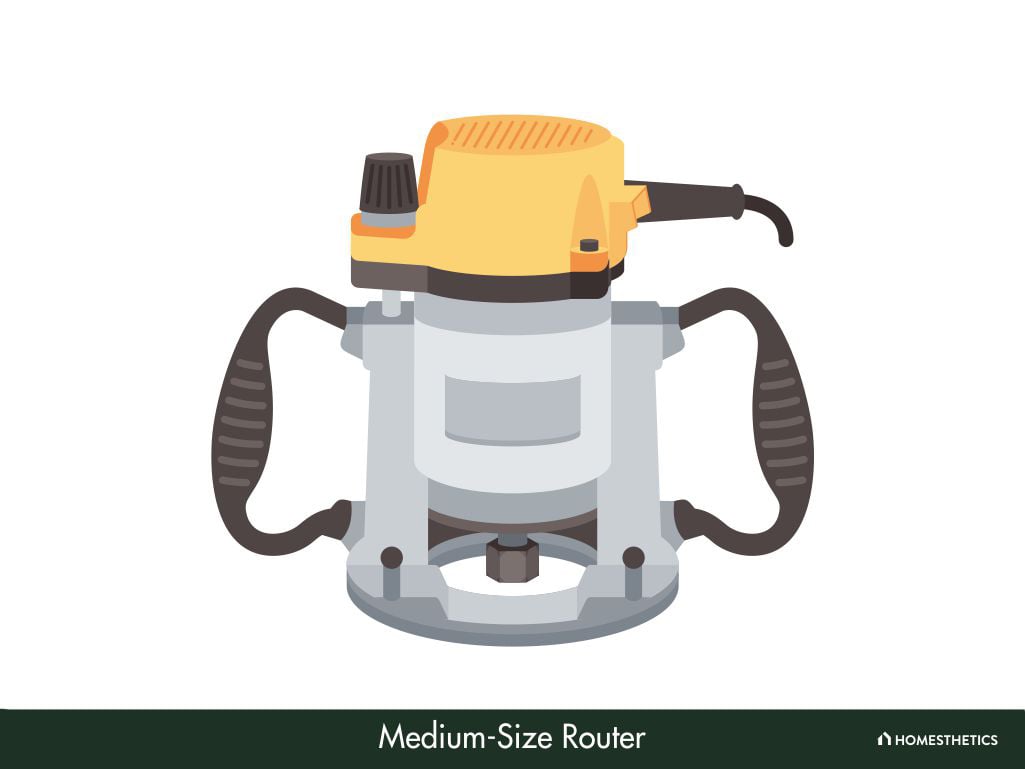
A medium-size router, which is otherwise known as a medium-duty router, is a type of professional-grade tool. This type of router is a lot more versatile and powerful than a light-size router, which is why it is commonly used by experienced DIYers and woodworkers.
However, they are not as powerful as heavy-size routers, which gives them an intermediate level of proficiency and versatility. The drill bits and collets are larger than the ones used in light-duty routers but smaller than those used in heavy-size routers.
Based on my tests, I found that these components are around 0.5 inches in most cases. The motors have an intermediate level of effectiveness, too. They can be generally used for prolonged periods but are not suitable for hard surfaces.
These above reasons make medium-duty routers suitable for most types of woodworking jobs as long as they are performed in a controlled manner. So, if you intend to use these routers for heavy loads, you will find them to be relatively inefficient.
3. Heavy-size router
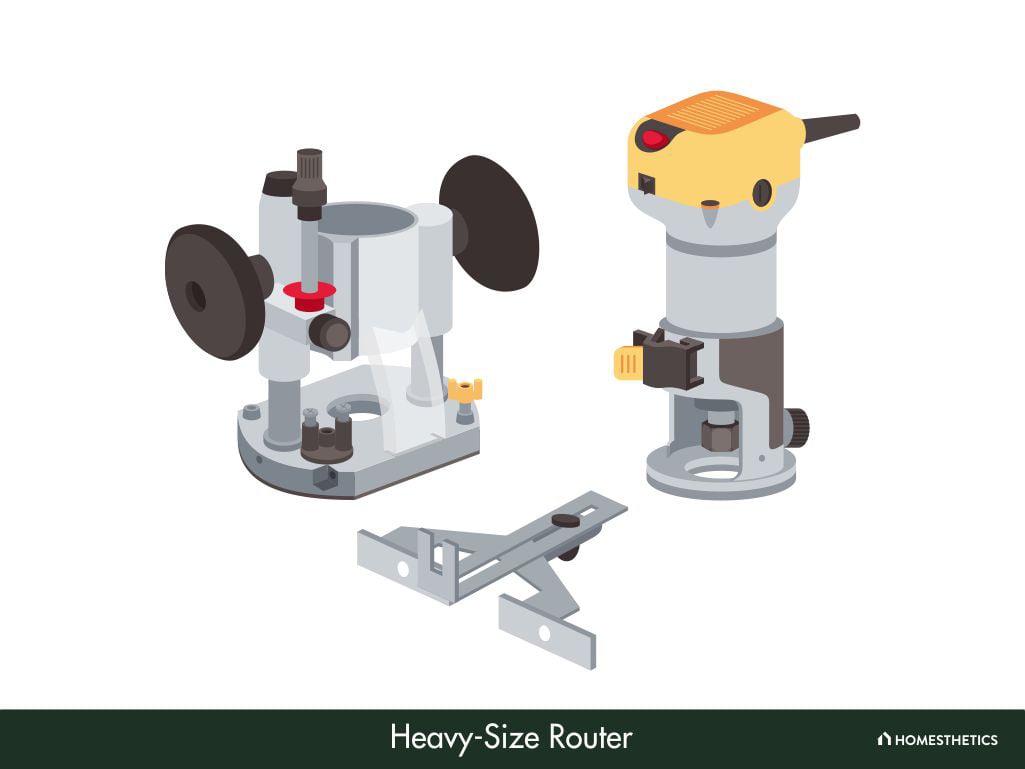
The last type of router that I will be discussing is the heavy-size router. Most routers of this type have considerable weight and large dimensions and are designed to handle heavy-duty woodworking projects. That is why they are also known as heavy-duty routers.
These routers have the largest collet sizes, and they can accommodate router cutters that are around 1.5 inches in diameter. Thanks to that, you can use them for drilling or cutting through the toughest materials, such as dense hardwood, plastic, steel, and so on.
Aside from that, a typical heavy-size router is equipped with a powerful motor that can be used for extended periods. This electric motor can spin the drill bit at extremely high speeds for maximum drilling effectiveness. On that note, such a motor generally comes with variable speed settings, which means that you can spin it at a lower speed, too, if necessary.
3 important router components to consider
Now that you know about the different types of routers, you should get some idea about some of the essential router components that can help with your woodworking projects. These components are mostly removable or interchangeable and can help to alter the specifications of this power tool.
1. Router bits
The router bit is one of the most crucial components in this machine since it helps to drill through the work surface. Normally, the shanks of router bits range between 0.25 and 0.5 inches in length. Apart from that, the tip styles differ depending on the type of task.
2. Router table
A router table is an optional component that acts as a fixed workstation, provided. It can make complex woodworking tasks fairly simple, which makes them a great choice for beginners. However, it sacrifices the mobility of the router in favor of convenience. Also, you have to ensure that the table is placed on an even surface, or else it will not be very useful.
3. Router jigs
Router jigs are tools that help in guiding the drill bit. This component can ensure higher accuracy, which makes it particularly effective when cutting joints or performing precision tasks.
What is a soft starter in a wood router?
A soft starter is a component in a wood router that gives you better control when starting up the motor. Many router models have motors that come with relatively high horsepower ratings and torque. On starting up such a powerful motor, you might experience a significant kickback, where the router will jump in your hands, making you lose control. That is why a soft starter is used, as it can prevent such kickbacks.
What type of router should I buy?
The type of router you should buy depends on what type of tasks you wish to do, as well as your expertise level. If you want to perform small projects or are new to woodworking, you can use light-size or even compact, cordless, or plunge routers. But if you have sufficient experience and want to undertake complex projects, you would be better off with any of the other types of routers.
Can I control the depth of the router drill bit?
Yes, you can control the depth of the router drill bit on many router models these days. Such a feature offers more flexibility to the machine, especially when used alongside variable speed settings and other similar features. Not all brands provide depth control settings on routers, though, which means that you will have to check this aspect before purchasing.
What are the best brands for routers?
Some of the best brands for routers that I would recommend are DeWalt, Makita, Milwaukee, and Bosch. Each of these recommended brands has demonstrated consistently high standards through rigorous testing and customer feedback.
Although there are numerous other brands in the market, not all maintain the same level of quality and performance. Therefore, it's wise to consider these trusted brands when purchasing a router.
With that, I have arrived at the end of this guide about the different types of routers. Now that you know all about this aspect, you can finally get to select the best one for your woodworking needs.
Of course, you will need to keep different factors in mind while making the final purchase. These factors include things like the power of the motor, the size and type of the drill bits and collets, handle configuration, dust collection, and disposal features, and others.
The above features will help you to get the best value for your money. So, you should not overlook them at any cost.
